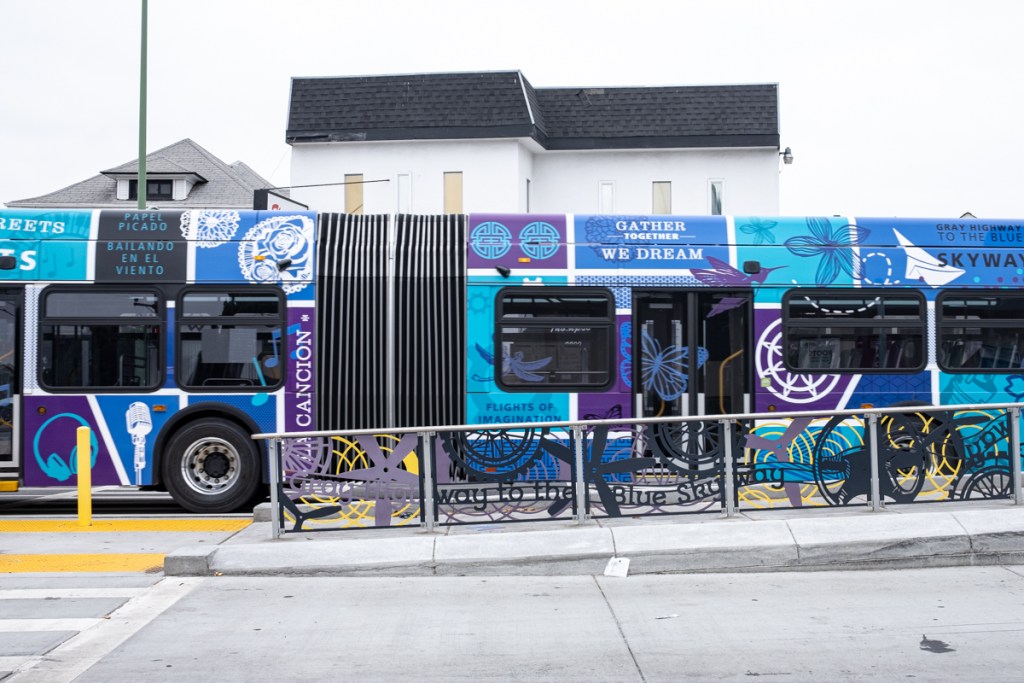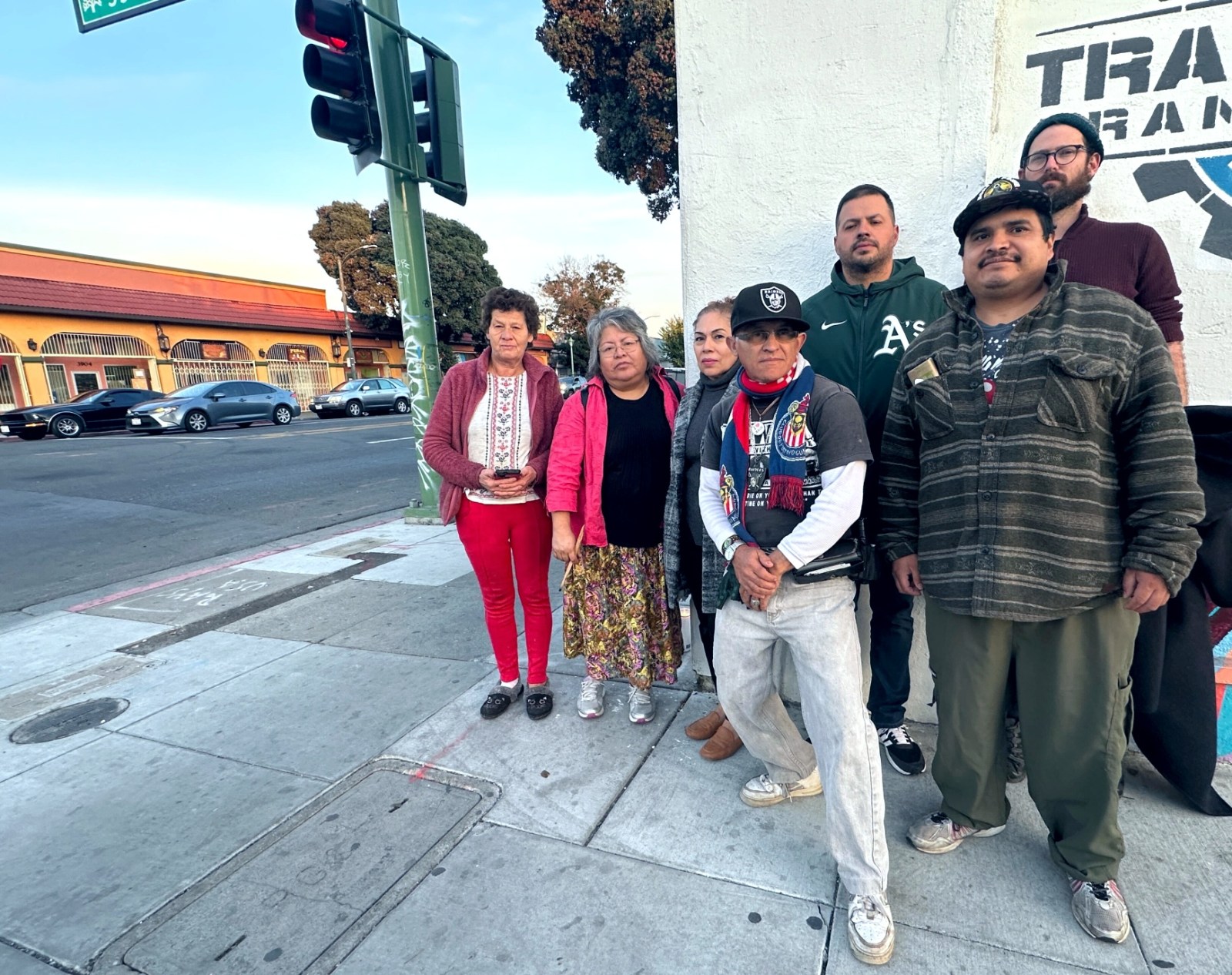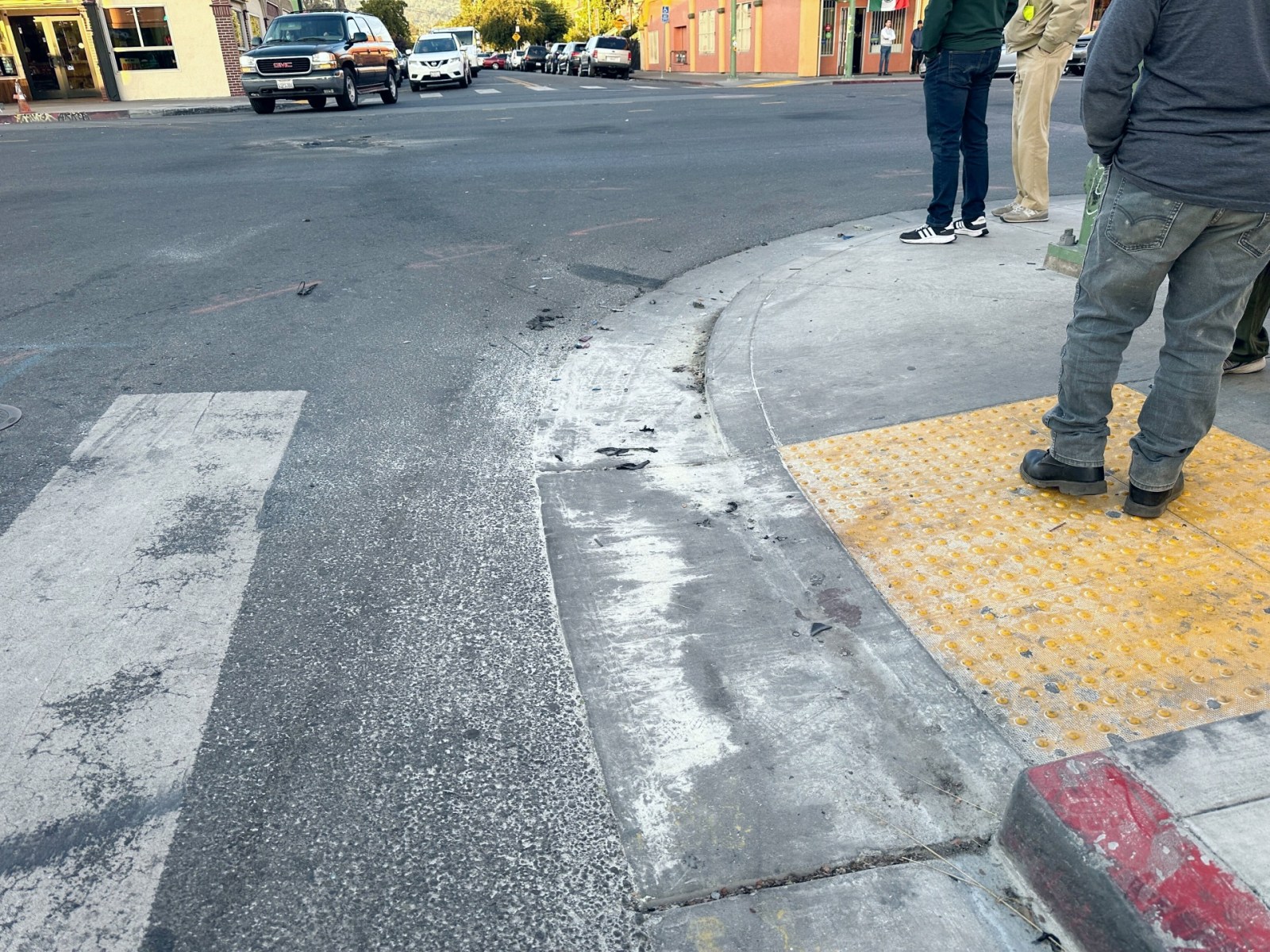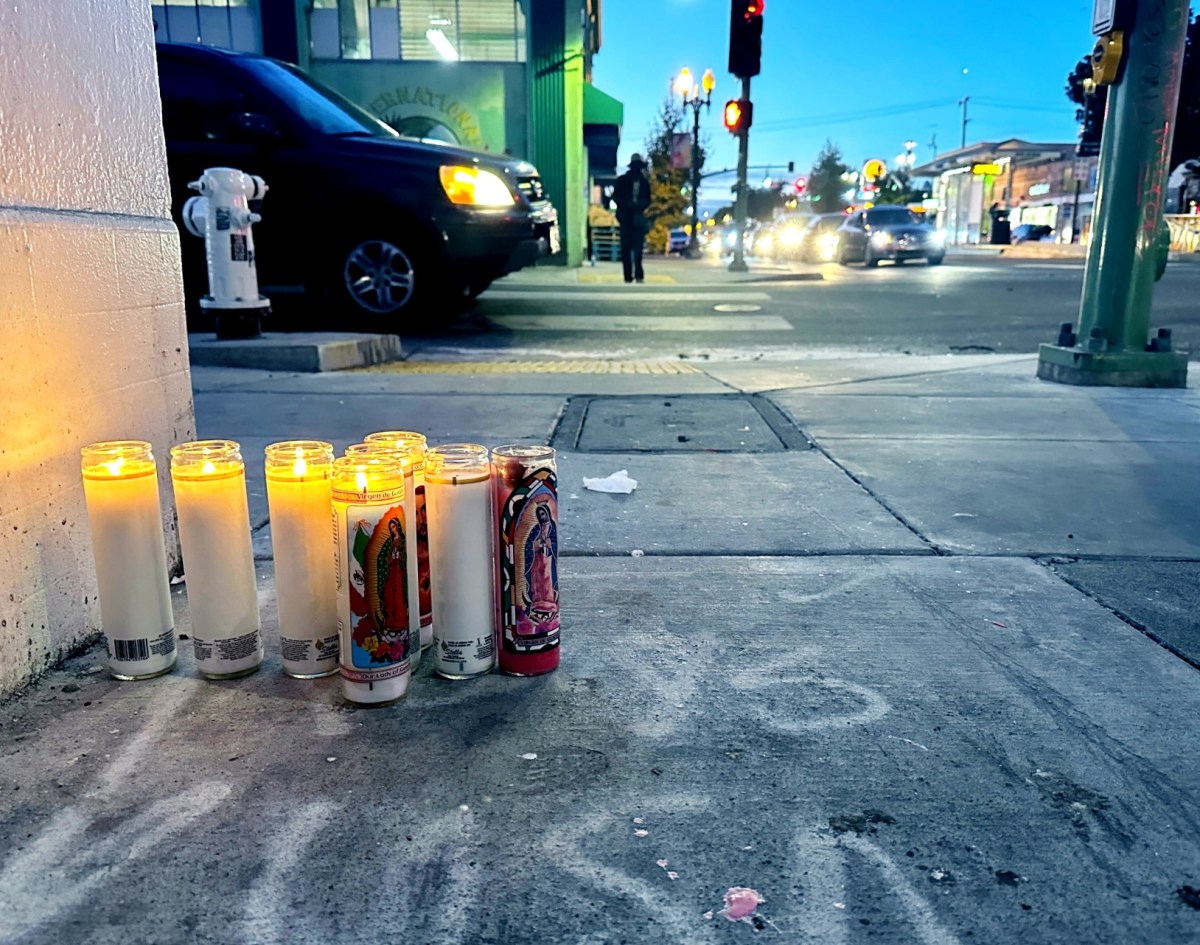Three years after AC Transit installed a new rapid bus line on International Boulevard in East Oakland, the regional agency now has permission to add a design update that some safe-streets advocates say will save lives.
Last week, AC Transit engineers announced that Caltrans, the state’s transportation department, approved an “encroachment” permit needed for a “quick build” to improve the bus line, known as the Bus Rapid Transit (BRT) Tempo line. The changes will include adding plastic bollards along several points of the BRT’s dedicated bus lane and the main roadway. AC Transit and the city of Oakland needed the permit to build on International Boulevard because it is technically a state highway, where Caltrans has jurisdiction.
The absence of a physical barrier between the dedicated bus lane and roadway has encouraged drivers stuck in traffic to illegally swerve into the bus lane and speed past other drivers, a dynamic that has caused collisions with other vehicles and caught-off-guard pedestrians, some of them fatal.
AC Transit communications officer Robert Lyles told The Oaklandside that the permit allowance helps the agency start the process of soliciting bids from construction contractors. Lyles said he expects the agency to advertise for these bids in mid-December “with proposal submissions expected by the close of January 2024.”
According to AC Transit’s dedicated page for the project, white vertical posts with a rubber composite or a low concrete base every 15 feet between the bus-only lane and the main roadway are expected to be added. Also likely are yellow bollards every 10 feet in areas of International where it’s easier for cars driving in opposing directions to run into each other. These areas, such as between 21st Avenue and 23rd Avenue and between 29th Avenue and 42nd Avenue, currently have a double-striped yellow line and no physical median separation.
The project will also add new lane violation posts, speed limit signs, and new paint on the bus lanes, although there are already signs and paint that speeding drivers tend to ignore.
Safe-street advocates have noted that even after these additions, the safety infrastructure along the BRT won’t reach the level of the original designs shown to Fruitvale residents 15 years ago, which included physical separations between the bus lane and the main roadway, including concrete curbs and planted separators.
Bike East Bay’s Robert Prinz said last month it’s important for the people who approved the BRT to understand the scope of its problems and learn from them.
“Officials from Oakland, AC Transit, Caltrans [and] others need to reckon with how massively problematic the International BRT design is, fix it ASAP, [and] ensure future bus lane projects don’t replicate the errors,” he said.
AC Transit is working with the city’s transportation department on the improvement project, which is considered a pilot. The total cost to implement the updates split between the city and AC Transit, is about $2 million. The additions will not appear on every block of the BRT but on select portions of International Boulevard between downtown and 107th Avenue that the agencies have found to be the most dangerous. AC Transit will add bollards and signs from 14th Avenue to 42nd Avenue, and OakDOT will add them from 42nd Avenue to 107th Avenue.
The quick build will also add red paint to some parts of the corridor with the aim of reducing speeding, including from 42nd Avenue to 55th Avenue. Most sections of the BRT Tempo line in downtown Oakland already feature a red lane.

The quick-build updates were announced during last week’s AC Transit general board meeting by traffic engineer Will Buller. At the same meeting, AC Transit General Manager Michael Hursh was given approval by the board for expedited construction, permitting, and traffic control plans for a stretch of the project between 14th Avenue and 42nd Avenue.
At the meeting, Buller said the agency wants to implement additional quick-build projects on Durant Avenue in Berkeley and MacArthur Boulevard in Oakland in the coming years.
There is no official count of how many people have been hit since the BRT’s inception, and many residents living in the neighborhoods along International Boulevard whom we’ve spoken with say they choose not to contact the authorities when accidents occur, out of fear because of things like immigration status.
However, dozens of interviews with East Oakland residents over the last three years of reporting on this issue, coupled with research data from UC Berkeley’s Transportation Injury Mapping System, provide a broad understanding of the scale of the problem, and trends.
According to TIMS data, there were 512 crashes on International over a roughly 29-month period between Aug. 9, 2020—the day the Tempo bus line started—and Dec. 31, 2022, the last day for which collision data is currently available. By contrast, over the same length of time just prior to the Tempo line being added, there were 384 crashes.
Since the BRT was put in use, there have been at least 41 crashes that involved pedestrians at intersections along International Boulevard, and 573 people in cars suffered at least a minor injury from collisions, several of whom died at the scene or later in a hospital.
The BRT line has also resulted in some positive outcomes for bus riders. The service has cut the travel time between San Leandro and downtown Oakland in half, according to AC Transit.
East Oakland residents, business owners, and advocates think the additions won’t end the problem

Bryan Culbertson, a volunteer and the founder of Traffic Violence Rapid Response, a safe streets advocacy organization, said last week on Twitter it was “incredibly frustrating” that the quick build has taken “so long,” coming roughly a year since AC Transit announced it was working with the city of Oakland and state engineers to devise solutions.
“Plastic posts should be quick to install (and uninstall if there ends up being an issue). Hopefully, OakDOT can figure out how [they] can streamline so we can install plastic posts in weeks rather than over a year,” he said.
In an interview last week, the transit advocate also noted the plastic bollards might not work as well as tall concrete or metal medians, which are used for rapid bus lanes in other parts of the world. The planned improvements will deter some drivers from weaving and speeding, said Culbertson, “but drivers that don’t care about their cars will drive over it anyway.”
Last week, The Oaklandside spoke to a group of several business owners who’d gathered at the intersection of 39th Avenue and International to call for immediate improvements on the dedicated BRT lanes after a motorcyclist was hit and killed there the day before. Some said they have customers who no longer feel safe driving on International because they fear being in a collision. Many of the business owners said they now also fear for their own lives when crossing the street.
“It’s a mess,” said Dominic Prado, the owner of El Ultimo Baile, a restaurant near Fruitvale Plaza.
Some were still in shock a day after witnessing the horrific collision, which occurred after a motorcycle rider sped through the bus lane, crossed the intersection at 39th Avenue, and collided with a vehicle making a left turn. The motorcycle exploded on impact, and the driver, who had not been identified, was thrown in the air and landed on the corner while his body was on fire, according to the business owners and a security video they provided to The Oaklandside. Another local businessman used an extinguisher on the driver of the motorcycle, but the person later died.
Prado said he’d like to see officials add safety features on International that are more permanent than those being put in place by the quick build. “They’re doing a quick build because they can’t do the actual things that will stop it. They can’t add speed bumps because it’s more important [for them] how often the bus runs,” he said.
In a conversation with Prado and Culbertson at the vigil for the motorcycle driver, we discussed the possibility that a speed bump could be added at the exact location where the Tempo bus stops, taking advantage of the natural stopping point when riders board on and off.
At the vigil, residents discussed the idea that speed bumps could be added on the street next to the Tempo bus stops, where riders board on and off.
Another Oakland business person, Alejandra Salgado, the owner of Bakery El Sol, told us that she “constantly” sees people driving over 80 mph in the Tempo lane. She blames the lack of traffic law enforcement on International Boulevard as the main culprit. She remembers hearing AC Transit staff promise during the early phases of the BRT’s development that only buses would be allowed on the lane, and that tickets would be given out by the city or CHP officers to anyone who used it.
“I don’t know what happened, but they didn’t do it. So people take advantage of the fact that there’s hardly any bus traffic on that lane, and they go fast on it and run over people, including a mother and her baby a few years ago,” she said in her native Spanish. “There has to be responsibility and consequences [for those decisions].”

Leticia Chavez, who runs the Mexican restaurant Obelisco, blames AC Transit for the deaths of the people on the Tempo lanes. “Their job is to keep this service safe. Now they have to respond for those deaths because they have experimented here with this lane, and we are suffering,” she said.
Chavez added she’s only heard directly from AC Transit staff “once or twice” in the last six months, despite multiple requests to speak with them about the dangerous conditions. “All they need to do is come here to see the problem for at least an hour, and they will see how bad it is,” she said.
Business owner Rosalva Contreras told us the situation was particularly fraught with emotion for her because her 28-year-old son was hit by a car while using a crosswalk on International Boulevard and 35th Avenue in 2014. He survived but suffered brain damage.
“We’ve complained a lot about this issue over the last three years, and we are not surprised this happened yesterday,” she said of the motorcycle accident. Contreras surmised that some of the BRT issues in East Oakland—such as the lack of red paint to denote bus lines—would never be allowed in downtown or other parts of the city.
All of the business owners said they feared collisions along the BRT line would be unavoidable until safety upgrades are made. Like clockwork, Prado notified us on Tuesday night that another major collision had happened the previous night, at the intersection of Seminary Avenue and International. Witnesses said a person was run over once again.
Prado told us today that he is organizing a protest action on behalf of International Boulevard business owners for next Monday at 3 p.m., at the front of the main AC Transit building at 1600 Franklin Street. He said that if anyone wanted to join him, they could call him at 510-560-4401.

